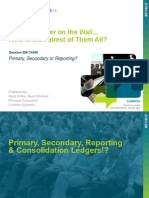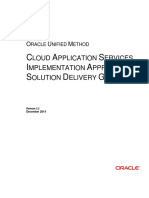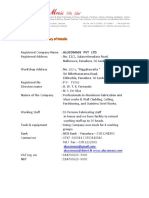Implementation Process
Implementation Process
Uploaded by
SureshCopyright:
Available Formats
Implementation Process
Implementation Process
Uploaded by
SureshOriginal Description:
Copyright
Available Formats
Share this document
Did you find this document useful?
Is this content inappropriate?
Copyright:
Available Formats
Implementation Process
Implementation Process
Uploaded by
SureshCopyright:
Available Formats
Implementation Process
What is Implementation ?
Once a Client purchase the Licenses of Oracle E-Business Suite, they will be
delivered a Standard Application Package. In the Standard Application Package
(Production Instance), they need to configure their Business Requirements as per the
Standard Business Procedures and their business practices. As a summary
Implementation is a process of configuring the application where their business needs is
working and their accounting structure is deriving the necessary accounting entries and
system is generating the Reporting as per the daily business needs, statutory requirements
and MIS reporting is generated in the Oracle E-Business Suite system
Types of Implementation
Vanilla Implementation Approach – Vanilla Implementation is Configure the Standard
Application as per the Standard Business Process without customizing any of the
components. The clients are very much flexible on utilization of the software features and
go accordingly as per the standards available in the E-Business Suite. So that they will be
benefits on Cost, Implementation time frame is reduced, Maximum utilization of
application features and minimum training needs. It’s a good approach for the customers
to start up there ERP practice with this implementation on the initial period, so that by
using the application for a period of time course of 6 Months to 1 Year for better
understanding the Oracle Application functionalities and features. Later if required if any
of the process needs to changed from the standard procedure they can plan for the
Customize Components where ever is required. In vanilla Implementation we can also do
a little bit of customization as a Cosmetic Changes.
Process Customization Approach – After a deep study of the business process and their
requirements, if the client wants to change Minor or Major application standard features,
then they can do a Customization in the E-Business Suite. Basically if there business
approach needs some more additional functionalities and more reporting needs which is
not delivered In the standard application as per the client required formats, then the
application will be modified, Customized and extended.
AIM – Application Implementation Methodology
Business Process Architecture (BP)
Business Requirement Definition (RD)
Business Requirement Mapping (BR)
Application and Technical Architecture (TA)
Build and Module Design (MD)
Data Conversion (CV)
Documentation (DO)
Business System Testing (TE)
Performance Testing (PT)
Adoption and Learning (AP)
Production Migration (PM)
Each Company has its own Implementation strategy and process on how to Start and End up
with a successful implementation which is derived from the AIM standards. As per my
Understanding the Implementation is divided into Different Phases. Below are the detailed steps
on How to Configure a Successful Implementation
Customer Activity
Procurement of E-Business Suite Licenses from Oracle or Oracle Partners
Get the Customer Support Identification Number (CSI) Number
Identify the Implementation Partners or Team
Phase I – Project Manager / Delivery Manager / Senior Functional Team / Customer
Managers
Identify Business Process Definition of Procure to Pay and Order to Cash Process
Identify the Organization Structure of the Customer and which Operating Units comes
under Oracle E-Business Suite Practice
1. One Organization operates in One Country
2. One Organization Operates in Multiple Country
3. Multiple Organization operates in One Country
4. Multiple Organization operates in Multiple Country
As an Implementation process, where they required E-Business Suite Practice, so that
plan and provide the Oracle Multi Organization Standards
Phase II - Project Manager / Delivery Manager / Senior Functional Team / Customer
Managers
Business Requirement Definition – Discuss and get Sign-Off from the Customer on what
is expected from Oracle E-Business Suite as Deliverables. It good if all the aspects are
discussed in detail to under the customer needs
Requirement Gathering on Business Process Model
Requirement Gathering on Financials Reporting
Requirement Gathering on Day to Day Task and Daily Reporting
Requirement Gathering on Auditing and Statutory Taxation Reporting
Requirement Gathering on Management Information System (MIS) Reporting
Fix a Time Line for the Deliverables and the Team who needs to Sing-off and Freeze
the Requirements
Data Conversion - Data Migration (If any data’s needs to be imported to Oracle E-
Business suite from Legacy System)
Phase III – Implementation Team / Functional Consultants / Associate Consultants /
Technical Team
Configure the CRP1 Instance mapping the applications as per the requirements
Identify the GAP between Application and Business Model
If any GAP is Analyzed Plan for the Customization Components (if Any GAP)
Phase IV – Technical Team and DBA Team
Build and Customization the Application for Indentified GAP between Application and
Business
Data Interface and Data Conversion – Legacy System Data’s
Patching and Cloning - Clone the CRP1 and CRP2 Instance to a GOLD and UAT
Instance
Plan for the Required Hardware and Software Supports
Prepare a Plan for Cloning / Back Up / Security Issues / Connectivity Issues
Prepare for Delivery to the Customers
Performance Testing by Implementation Team
Phase V - Implementation Team and Customer Team
User Acceptance Testing - Business Users Test the application as per the Business Needs
are configured as per the requirements sign-off Document
Minor Change Requests - Modify the Setup Configuration in the UAT and GOLD as per
the Business Team flexibility in case of any Minor Modification
Deliverables - Sign Off from the Clients on the Business Process Models
User Training as Per the Roles and Responsibility
Perform Scheduled Programs, configure Workflows and Alerts on the Exceptional Data's
to the Business Team
Documentation to be Delivered to the Clients
Deliverables of the Financials Reporting for Daily Basis
Deliverables of the Taxation Reporting, Reconciliation Process and Statutory Reporting
Deliverables of the Month End Closure Reporting and Yearly Closure Procedures
UPK - Learning Management System Online Availability with Required Process
Documentation
Indentify the Module Features to maximum utilization of the Application
Configure the Production Sever with the Required setups and Data’s - Production
Migration - GO-Live
AIM Documentation
25 – Simple Steps to Make a Successful Implementation
1 Customer Support Identification Number (CSI Number) CSI
2 Download the Software and Install the CRP1 Instance CRP1
3 Indentify the Organization Structure and the Business Process of the Client BP
4 Requirement Gathering - Business Process Model RD
5 Requirement Gathering - Financials Reporting (Daily Reporting) RD
Requirement Gathering - Auditing and Taxation Reporting (Statutory
6 RD
Reporting)
7 Requirement Gathering - Management Information System (MIS Reporting) RD
8 Plan the Data Migration from the Legacy System CV
Identification of GAP Analysis - Model Design and Build (Cosmetic
9 MD
Changes)
Business Process Mapping (Configuration) into the CRP1 Instance as per
10 BR
collected Data's
Build and Customization the Application for Indentified GAP between
11 MD
Application and Business
12 Data Interface and Data Conversion CV
Patching and Cloning - Clone the CRP1 Instance to a GOLD and UAT
13 TA
Instance
User Acceptance Testing - UAT Performance Testing by Implementation
14 TE
Team and Business Team
Change Requests - Modify the Setup Configuration in the UAT and GOLD as
15 RD
per Business Team Flexibility
16 Deliverables - Sign Off from the Clients on the Business Process Models PM
17 User Training as Per the Roles and Responsibility AP
Perform Workflows and Alerts on the Exceptional Data's to the Business
18 TE
Team
19 Documentation to be Delivered to the Clients DO
20 Deliverables of the Financials Reporting for Daily Basis TE
Deliverables of the Taxation Reporting, Reconciliation Process and Statutory
21 TE
Reporting
Deliverables of the Month End Closure Reporting and Yearly Closure
22 TE
Procedures
UPK - Learning Management System Online Availability with Required
23 DO
Process Documentation
24 Indentify the Module Features to maximum utilization of the Application BR
25 Production Migration - GO-Live PM
You might also like
- General LedgerDocument2 pagesGeneral LedgerAbhi AbhiNo ratings yet
- Fusion Enterprise Structure OverviewDocument22 pagesFusion Enterprise Structure OverviewMohmed BadawyNo ratings yet
- White Paper-Simplifying Oracle Retail Data ConversionDocument6 pagesWhite Paper-Simplifying Oracle Retail Data ConversionSuman RamineniNo ratings yet
- GSI Fusion Receivables - AR To GL Reconciliation (R11D02)Document10 pagesGSI Fusion Receivables - AR To GL Reconciliation (R11D02)Andreea GeorgianaNo ratings yet
- Financial Reportingwith Essbase Sourcingfrom Oracle EBSDocument25 pagesFinancial Reportingwith Essbase Sourcingfrom Oracle EBSpavanNo ratings yet
- Oracle® Fusion Middleware: 2 Day Administration Guide 11g Release 1 (11.1.1)Document114 pagesOracle® Fusion Middleware: 2 Day Administration Guide 11g Release 1 (11.1.1)varma98No ratings yet
- ActivityGuideR10 v6Document375 pagesActivityGuideR10 v6Kotesh KumarNo ratings yet
- Oracle Revenue Management and Billing Garbling Customer InformationDocument8 pagesOracle Revenue Management and Billing Garbling Customer InformationsaheemmirNo ratings yet
- Oracle ERP Cloud Service Integrations OverviewDocument12 pagesOracle ERP Cloud Service Integrations OverviewSergeyNo ratings yet
- FAH Course ContentsDocument3 pagesFAH Course Contentskrishna panchangamNo ratings yet
- Oracle Advanced CollectionsDocument3 pagesOracle Advanced CollectionsVinita BhatiaNo ratings yet
- Oracle Financials Cloud 2018 PreSales Specialist 15QsDocument5 pagesOracle Financials Cloud 2018 PreSales Specialist 15Qsabebe0% (9)
- EBS-Strategy-12 2 5Document100 pagesEBS-Strategy-12 2 5ahmed_sftNo ratings yet
- R12 India Localization Technical OverviewDocument86 pagesR12 India Localization Technical OverviewRamesh Babu Pallapolu100% (2)
- Configuring and Extending ApplicationsDocument258 pagesConfiguring and Extending ApplicationsMd AhmedNo ratings yet
- Implementation - Real Time Type of Projects: ND RDDocument14 pagesImplementation - Real Time Type of Projects: ND RDKrishaNo ratings yet
- Using Ai Apps For FinancialsDocument28 pagesUsing Ai Apps For FinancialsAchinthya DinoliNo ratings yet
- Oracle Financial ConsultantDocument3 pagesOracle Financial ConsultantAbdulrahman Fouad SabitNo ratings yet
- Bi Publisher PDFDocument426 pagesBi Publisher PDFNalini TiwariNo ratings yet
- Oracle Financials For India Implementation GuideDocument178 pagesOracle Financials For India Implementation Guidekpat3100% (1)
- Oracle 12 Receivables External Bank Account UptakeDocument15 pagesOracle 12 Receivables External Bank Account UptakeappsrajeshoracleNo ratings yet
- Oracle Fusion Applications CRM Extensibility GuideDocument54 pagesOracle Fusion Applications CRM Extensibility GuideBala SubramanyamNo ratings yet
- Erptree Com r13 Fusion PPM Course ContentDocument6 pagesErptree Com r13 Fusion PPM Course ContentMahmoud Abed ElbestawyNo ratings yet
- Fusion Procurement Applications Guide PDFDocument244 pagesFusion Procurement Applications Guide PDFRammohan PushadapuNo ratings yet
- Key Features: DATA SHEET / Oracle Global PayrollDocument3 pagesKey Features: DATA SHEET / Oracle Global PayrollBarış Ergün0% (1)
- BP040 Current Process ModelDocument12 pagesBP040 Current Process ModelarubharraniNo ratings yet
- BP040 Current Process ModelDocument12 pagesBP040 Current Process ModelOdair MeloNo ratings yet
- Creating and Initializing Oracle® Hyperion Workforce Planning, Fusion Edition 11.1.2 ApplicationsDocument1 pageCreating and Initializing Oracle® Hyperion Workforce Planning, Fusion Edition 11.1.2 ApplicationsMNo ratings yet
- Configuring Approval Rules Using Advanced Mode in Oracle BPM Worklist Worked ExampleDocument13 pagesConfiguring Approval Rules Using Advanced Mode in Oracle BPM Worklist Worked ExampleAhmedNo ratings yet
- 1 Oracle Financials TheoryDocument174 pages1 Oracle Financials Theorysherif hassan younisNo ratings yet
- Period End Processing - Summary The Following Outlines:: PayablesDocument3 pagesPeriod End Processing - Summary The Following Outlines:: Payablesbritesprite2000No ratings yet
- Utilize FSM To Migrate Oracle ERP Cloud Reference Data April 2016Document19 pagesUtilize FSM To Migrate Oracle ERP Cloud Reference Data April 2016gule29No ratings yet
- Oracle EPM at OracleDocument21 pagesOracle EPM at Oraclekabch00No ratings yet
- Ledger Ledger On The Wall - Presentation-V4Document38 pagesLedger Ledger On The Wall - Presentation-V4Hans KolbeNo ratings yet
- QA-Fusion Applications Introduction To Financials Implementation PDFDocument3 pagesQA-Fusion Applications Introduction To Financials Implementation PDFramansingan100% (1)
- D96356GC10 Introduction To Oracle Financials Cloud Sample PDFDocument30 pagesD96356GC10 Introduction To Oracle Financials Cloud Sample PDFsw21910No ratings yet
- EBS FAH12BestImplPractices PDFDocument34 pagesEBS FAH12BestImplPractices PDFSingh Anish K.No ratings yet
- Ebs r12 Accelerators 069695Document2 pagesEbs r12 Accelerators 069695Carlos Gutierrez CallejaNo ratings yet
- Oracle® Order Management Electronic Messaging IMDocument178 pagesOracle® Order Management Electronic Messaging IMharsoftNo ratings yet
- Oracle 12 Receivables Subledger Accounting - ReceivablesDocument15 pagesOracle 12 Receivables Subledger Accounting - ReceivablesappsrajeshoracleNo ratings yet
- 10 - Creating Smart View ReportsDocument20 pages10 - Creating Smart View ReportsMahesh PrasadNo ratings yet
- AP Volume 11 - LATESTDocument101 pagesAP Volume 11 - LATESTTrain TNo ratings yet
- Narasimha RaoDocument3 pagesNarasimha RaoMahesh MahiNo ratings yet
- Build Oracle ERP R12, 11i General Ledger Financial ReportDocument2 pagesBuild Oracle ERP R12, 11i General Ledger Financial ReportzoneglNo ratings yet
- R12 Inter Company BalancingDocument6 pagesR12 Inter Company BalancingRaghurami ReddyNo ratings yet
- George ETuk - Oracle Implementation Manager - Big Four Consulting ExperienceDocument8 pagesGeorge ETuk - Oracle Implementation Manager - Big Four Consulting ExperienceAnonymous VhXj3gJmhqNo ratings yet
- Oracle ERP Implementation Project Excution PlanDocument4 pagesOracle ERP Implementation Project Excution PlanalbagirshareifNo ratings yet
- R11 Extension TablesDocument16 pagesR11 Extension TablesManikumar KollaNo ratings yet
- CE GSE Meeting - Cash Position and Cash Forecast ReportsDocument12 pagesCE GSE Meeting - Cash Position and Cash Forecast ReportsELOUSOUANINo ratings yet
- Internet Expenses Data SheetDocument2 pagesInternet Expenses Data Sheetmiguelsias127100% (1)
- SAP Vs Oracle Case StudyDocument11 pagesSAP Vs Oracle Case StudyManish Jain100% (1)
- Oracle PCG - GRCDocument60 pagesOracle PCG - GRCsubhashramNo ratings yet
- Oum Cloud Application Services Implementation Approach PDFDocument161 pagesOum Cloud Application Services Implementation Approach PDFMarwan SNo ratings yet
- Implementing Lease AccountingDocument32 pagesImplementing Lease AccountingParesh KashyapNo ratings yet
- Financials Reports R13Document95 pagesFinancials Reports R13Verina FahimNo ratings yet
- Oracle Fusion Applications A Complete Guide - 2019 EditionFrom EverandOracle Fusion Applications A Complete Guide - 2019 EditionNo ratings yet
- The Business Analyst's Guide to Oracle Hyperion Interactive Reporting 11From EverandThe Business Analyst's Guide to Oracle Hyperion Interactive Reporting 11Rating: 5 out of 5 stars5/5 (1)
- Accounting Events: Accounting Events 422990027.doc Effective Mm/dd/yy Page 1 of 17 Rev 1Document17 pagesAccounting Events: Accounting Events 422990027.doc Effective Mm/dd/yy Page 1 of 17 Rev 1SureshNo ratings yet
- (Release 12) Documentation Titles Part Number PDF File: TechnologyDocument8 pages(Release 12) Documentation Titles Part Number PDF File: TechnologySureshNo ratings yet
- Period Close Processing Checklist - R12 Receivables: Previous PostDocument1 pagePeriod Close Processing Checklist - R12 Receivables: Previous PostSureshNo ratings yet
- P2P Lifecycle:: Procuer To Pay Life CycleDocument2 pagesP2P Lifecycle:: Procuer To Pay Life CycleSureshNo ratings yet
- Introduction To Oracle EusinessDocument35 pagesIntroduction To Oracle EusinessSureshNo ratings yet
- Period Close Processing Checklist - R12 Receivables: 1. 2. 3. 4. 5. 6. 7. o o o o o 8. o o o o o o o 9. 10. 11Document2 pagesPeriod Close Processing Checklist - R12 Receivables: 1. 2. 3. 4. 5. 6. 7. o o o o o 8. o o o o o o o 9. 10. 11SureshNo ratings yet
- Period Close Processing Checklist - R12 General LedgerDocument5 pagesPeriod Close Processing Checklist - R12 General LedgerSureshNo ratings yet
- ALSPA SV System DatasheetDocument3 pagesALSPA SV System DatasheetGavinsiauNo ratings yet
- IDEA Corbel 8: User GuideDocument30 pagesIDEA Corbel 8: User GuideDipak BorsaikiaNo ratings yet
- Renewable and Non Renewable ResourcesDocument40 pagesRenewable and Non Renewable ResourcesChristian John Musngi50% (2)
- Mbeya University of Science and Technology: List of Selected Bachelor Students For The Academic Year 2020/2021 (ROUND 1)Document114 pagesMbeya University of Science and Technology: List of Selected Bachelor Students For The Academic Year 2020/2021 (ROUND 1)Franck LucaNo ratings yet
- Logistics: Click To Edit Master Subtitle StyleDocument11 pagesLogistics: Click To Edit Master Subtitle StyleMahesh M. NairNo ratings yet
- Manual Isl A-B Linear-ScaleDocument7 pagesManual Isl A-B Linear-Scaletrần thị dungNo ratings yet
- Comau Robotics c5g User Maintenance Manual 103Document103 pagesComau Robotics c5g User Maintenance Manual 103MilosNo ratings yet
- Verification Manual: WR Written By: The Soilvision Systems Ltd. Team Last Updated: Tuesday, February 20, 2018Document49 pagesVerification Manual: WR Written By: The Soilvision Systems Ltd. Team Last Updated: Tuesday, February 20, 2018Nilthson Noreña ValverdeNo ratings yet
- Chapter 9 - Troubleshooting and Replacement Procedures Rev2.1Document27 pagesChapter 9 - Troubleshooting and Replacement Procedures Rev2.1Adeel AbbasNo ratings yet
- CXC - 075e - CODE OF HYGIENIC PRACTICE FOR LOW-MOISTURE FOODSDocument21 pagesCXC - 075e - CODE OF HYGIENIC PRACTICE FOR LOW-MOISTURE FOODSChrisa KargiotouNo ratings yet
- Expulsion Fuse Links For Use in High Voltage (Liston Fusible)Document36 pagesExpulsion Fuse Links For Use in High Voltage (Liston Fusible)Leon OrtegaNo ratings yet
- Hyperlynx TutorialDocument14 pagesHyperlynx Tutorialabdallah meziti-proNo ratings yet
- Unreacted Monomer 2000Document4 pagesUnreacted Monomer 2000marishaNo ratings yet
- M Family Digital Ground Protection RelayDocument3 pagesM Family Digital Ground Protection RelayCarpeDiem82No ratings yet
- Ultrasonic Sensor AlarmDocument21 pagesUltrasonic Sensor Alarmzukinet103No ratings yet
- Pistoane JapanDocument293 pagesPistoane JapanCatalin NistorescuNo ratings yet
- Introduction To Food Chemistry PDFDocument37 pagesIntroduction To Food Chemistry PDFTassy PutriNo ratings yet
- List Data Barang GudangDocument6 pagesList Data Barang GudangErwin SyahNo ratings yet
- Clinical IVRSDocument5 pagesClinical IVRSTuyet-Lan BuiNo ratings yet
- BW4HANA - WebinarDocument44 pagesBW4HANA - Webinarrahulsindhwani100% (1)
- Ishan Equipments Pvt. Ltd. (Unit-Ii) : Form Iv ADocument3 pagesIshan Equipments Pvt. Ltd. (Unit-Ii) : Form Iv AJaysinh KumpavatNo ratings yet
- ANT A264518S0 0834 DatasheetDocument2 pagesANT A264518S0 0834 DatasheetОлександр ЧугайNo ratings yet
- Krovni VentilatoriDocument6 pagesKrovni VentilatoridrbaneNo ratings yet
- Brindavan College of EngineeringDocument5 pagesBrindavan College of EngineeringadmissiondetailsNo ratings yet
- Method 1664 Revision B N Hexane Extractable Material HEM Oil and Grease and Silica Gel Treated N Hexane Extractable Material SGT HEM Non Polar Material by Extraction and GravimetryDocument35 pagesMethod 1664 Revision B N Hexane Extractable Material HEM Oil and Grease and Silica Gel Treated N Hexane Extractable Material SGT HEM Non Polar Material by Extraction and GravimetryAlvaro CorreaNo ratings yet
- GMP Checklist For PremisesDocument2 pagesGMP Checklist For PremisesEtta Jenee100% (1)
- Multilevel Level Single Phase Inverter Implementation For Reduced Harmonic ContentsDocument11 pagesMultilevel Level Single Phase Inverter Implementation For Reduced Harmonic ContentsInternational Journal of Power Electronics and Drive SystemsNo ratings yet
- Career in Oil & Gas Industry: Career Days - Sekolah Victory PlusDocument11 pagesCareer in Oil & Gas Industry: Career Days - Sekolah Victory PlusAbdul HalimNo ratings yet
- FurReal Friends Butterscotch Pony 76471Document4 pagesFurReal Friends Butterscotch Pony 76471Tanja26No ratings yet
- AlucoMass Profile UpdateDocument4 pagesAlucoMass Profile UpdateWajira FernandoNo ratings yet
































































































